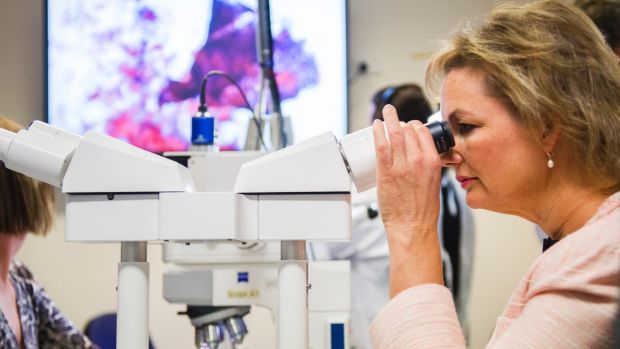
Health Minister Sussan Ley tours the pathology laboratory at Canberra Hospital. Photo: Rohan Thomson
Australian women will benefit from a cutting-edge new cervical cancer screening program that will increase survival rates and reduce the number of invasive procedures they have to endure throughout their lives.
Federal Health Minister Sussan Ley will announce today that the Abbott government will invest in the national rollout of the new and much more effective test as part of a $600 million cancer-fighting package to be included in Tuesday’s budget.
The test works by detecting the cervical cancer-causing human papillomavirus? (HPV) before abnormal cell changes occur. It will only be required once every five years and will replace the current two-yearly pap test.
Australia will be only the second country in the world after the Netherlands to adopt the test as part of a national screening program.
The government believes the test – which will be made available on Medicare to all women aged 25 to 74 from May 2017 – will help prevent an extra 15 per cent of cervical cancer cases.
“As they say, prevention can be as good as a cure and this is important news for Australian women that could literally save their life,” Ms Ley said.
The move is in line with recommendations made to the government earlier this year by the Medical Services Advisory Committee.
Ms Ley will also announce a National Cancer Screening Register to increase screening rates across the country.
The register will support the newly expanded national bowel cancer screening program combined with the new national cervical screening program.
Currently there are eight separate state-based cervical screening registers and an outdated, paper-based bowel screening register.
“It can be difficult to keep track of your screening requirements, which is why we are investing in the creation of a single national screening register for cancers to ensure all Australians can remain up to date,” Ms Ley said.
Paul Grogan, director of public policy at Cancer Council Australia, said the government should be commended for taking its cancer screening programs further.
“When it comes to cervical cancer Australia has one of the world’s lowest mortality rates largely due to the effectiveness of the cervical screening program. Shifting to the new system in 2017 will make the program even more effective,” he said.
Ms Ley’s latest announcements come a day after she revealed the government would invest $1.3 billion listing new medicines and vaccines on the Pharmaceutical Benefits Scheme, including drugs to help beat melanoma and breast cancer.
Trametinib? will be listed on the PBS at a cost of $437 million over four years and will help more than 1000 patients with melanoma. The drugs pertuzumab and trastuzumab emtansine? will help around 600 breast cancer sufferers every year at a cost to the government of about $190 million over four years.
Ms Ley says one in every six dollars of the almost $10 billion invested in the PBS is now spent on cancer treatments.
